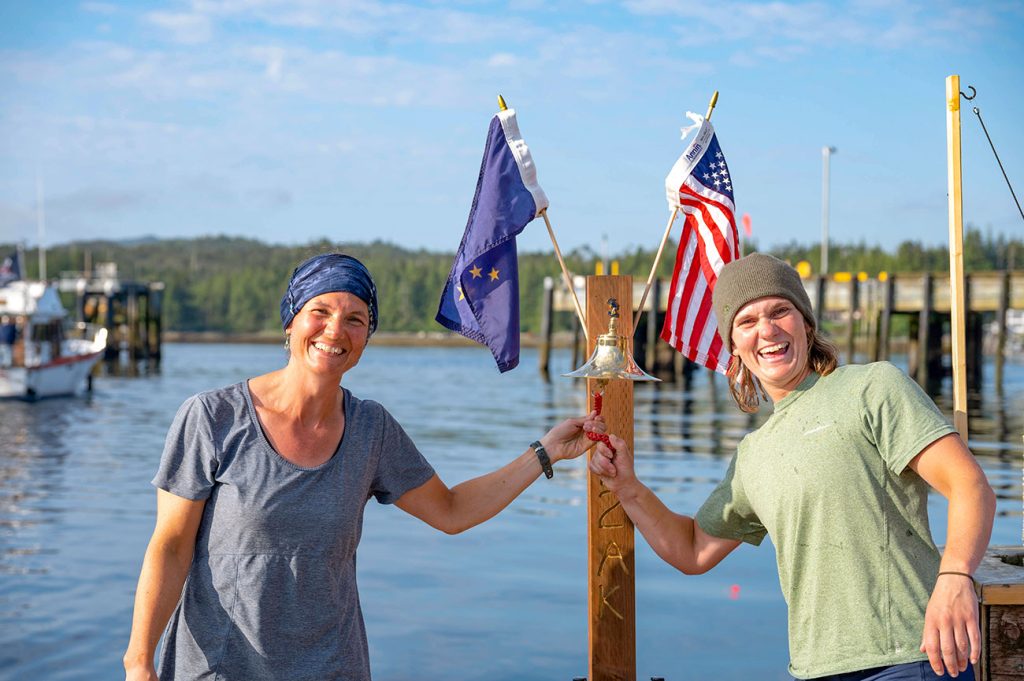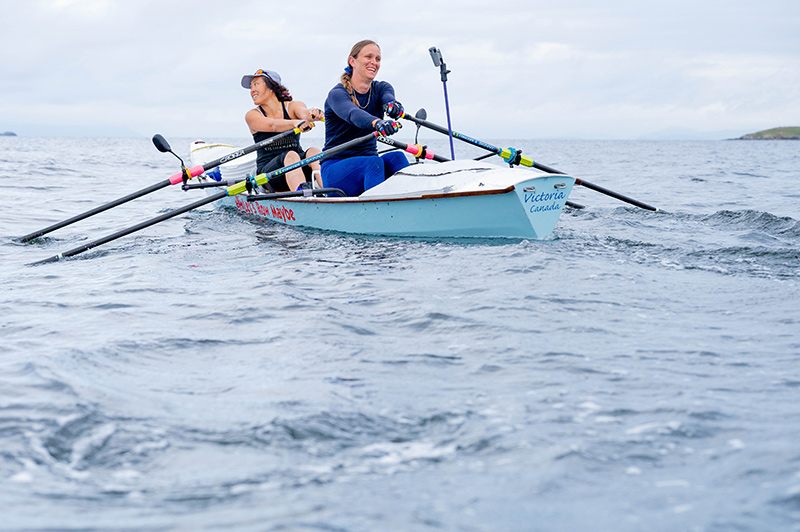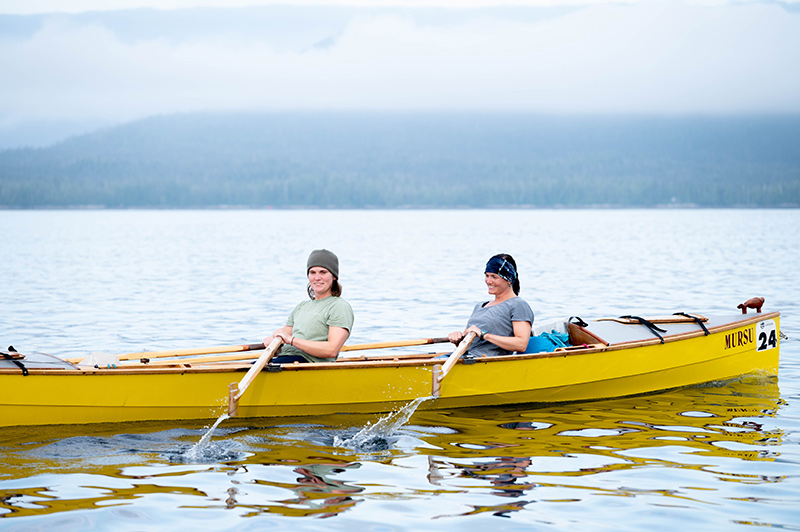Field Report
photo: Team Don’t Tell Mom by Rebecca Ross
It may not be true, but yesterday was the hottest it has ever been in Ketchikan. At 7:03 AM AKDT, when Team Don’t Tell Mom pulled their final boat length of water to become the first human-powered finishers in 2022 and the first all-women rowing crew in the history of R2AK, it was t-shirt weather. It was damn hot.
Now, before this update becomes cited in some scientific journal on climate change, you should know Ketchikan has nice weather. Except for every day that it doesn’t. Which isn’t many, but this was one of them. It was warm and made it difficult to think about snow. Because snow will help you imagine what was accomplished yesterday as our first two all-muscle teams found whatever the boat version of a checkered flag is.
Imagine you and a friend standing in a field stretched to the horizon, blanketed in heavy, wet snow. You two must cross said field, and all you have is a shovel. So, you dig into the snow, lift a load, throw the snow aside, and take a step forward. You do it again and again. Every time you want to step toward your goal, you must move a load of snow, and every time you stop, nothing changes. You don’t move until you start shoveling.
Add to this nearly exhausting analogy the need to drag behind you: your kitchen, bedroom, wardrobe, water, general survival gear, and a red blinking SPOT tracker some sadist named Jesse made you add to the pile. Then shovel snow over ¾ of a million times. Shovel from Paris to Rome. Edmonton to Winnipeg. Shovel and walk from Seattle to San Francisco.
Teams Don’t Tell Mom (DTM) and Let’s Row Maybe? (LRM) shoveled their way to Ketchikan, facing backward the entire time. They did not stop when blisters covered ⅓ of their hands or appeared on their feet. They kept going after nightly swarms of mosquitoes, seas reaching over their heads, and campsites that were little more than skimpy pebble beaches disappearing in the tidal rise.
And both teams broke the old record for the fastest “oars only” to Ketchikan, beating Leigh’s first record-setting row from 2019 (17d 5h 38m) when she shoveled the course with Dameon Colbry as Team Backwards AF.
DTM: 15d 20h 3m
LRM: 16d 8h 35m
It’s pretty easy to wonder why anyone would sign up for a 750-mile boat race and not at least figure out a way to tie a poncho to an oar and get a little help when the wind’s in your favor. But high stakes adventure is not the time to take up a new outdoor hobby. You’re going to succeed only on your own terms, and you have to play to your strength. The positive trade-off to rowing is you can point that boat any direction you please and don’t have to fuss with sailor jargon, tacking angles, halyard tension, vang tension, shrouds, or sail theory, for that matter. They didn’t even use rudders. Headwinds, however, offer a lot less advantage. This year was defined by so many days of relentless headwinds that, when four hours from Ketchikan and the seas went from calm to once again blowing straight at them, Carling of LRM lost it. Akin to metal reaching the point where it begins to melt, Carling had had enough. But there is no pause, no sailing in circles to collect your shit. Any time spent not rowing into a headwind is time going in the wrong direction.
Watching the Race Tracker, you’d guess the two teams were almost buddy boating and planned it out beforehand. Their paths constantly crossed. However, even camping short miles from one another and rowing near-identical routes, they rarely even knew the other team was in the area. The only thing they shared was a weather system.
Leigh and Clare (DTM) are sisters and Mainers, were recruited to the US Coast Guard, and made a habit of rowing that came from having painfully curious minds and growing up around too much water. Michelle and Carling (LRM) have lined their adventure resumes with professional rowing. Michelle raced in college and performed as captain of the US team for the World Championships of Coastal Rowing. Carling is a two-time Olympian for Canada in single sculls. She’s so famous that we decided to steal quotes from her interview about the race with Rowing World to compare her thoughts before and after R2AK.
Then: It’s not like I’ll be losing fitness on this trip.
Now: I lost 15 pounds during the race.
Then: It doubles as a bit of a break but also a training camp; it will be fun for sure.
Now: This should be called the toughest race in the world. I was pushed to my physical max every day. It was the hardest thing I have ever done.
Don’t Tell Mom was dubbed the Ninja Team by Michelle for their early departures. “Every time we camped by them, they were already gone by the time we got up.” For Don’t Tell Mom the early morning departures felt key to coming in over 12 hours ahead of Let’s Row Maybe. “Leigh is competitive,” said Clare. “The last morning, I wanted to sleep in, but Leigh wouldn’t let me. She was too worried the other team would get a head start.” After a 70-mile row the day before, DTM slept for only two hours before the final push into Ketchikan.
But each team’s rhythms were amazingly similar, though offset by a few hours.
2 – 12 – 2 – 8 | 2 – 12 – 2 – 8 | 2 – 12 – 2 – 8
The metered regularity of their day, though started at different times, fell into a routine that was born from necessity rather than desire.
2 hours to eat, break down camp, and get the boat ready
12 hours of rowing
2 hours to eat, set up camp, and put the boat to bed
8 hours of sleep
Repeat for almost two weeks.
As the two teams shared stories, there wasn’t a lot of talk about ever wanting to do the race again, but at the same time Michelle declared, for maybe the fifth time, “I am never getting in that boat again!” A whisper came from the crowd that Leigh may already be thinking about 2023.
When we see these folks on the dock, it’s hard to nail down why distance rowers want to keep rowing distances. Part of it is undoubtedly measured in the conviction of the racers. When asked why, if the trip had so many impossible moments, they didn’t think about quitting, Carling immediately replied for them all, “You can’t stop. You can’t give up.” Also, there are moments of rowing where the rhythm can act as a tuning fork for the soul. When the pitch is perfect between oar blade and heart, the pace of time, water, and boat seem to match. For a minute, that sensation is worth all the pain. And you find yourself hoping the next minute will be the same. Everyone has their own interpretation of triumph and how they get there. For these two teams, different yet so similar, it is time for them to start telling their own. They sure earned it.
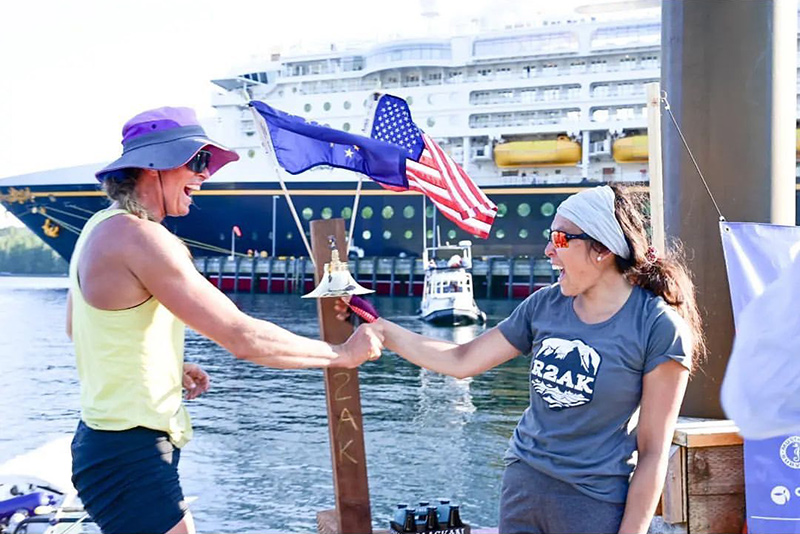
Field Report: Team Bangarang: A Homemade Boat, a Homemade Adventure
By Lynnette Oostmeyer, Field Reporter
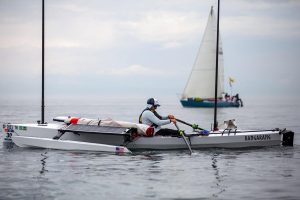
James Gibling of Team Bangarang says he found out about the Race to Alaska by accident. He was looking for a boat that he could row and sail, and he just happened to see a picture of Colin Angus standing up in a little boat, an Angus RowCruiser. He felt that this setup was exactly what he was looking for. After chatting with Colin he learned that the boat was originally designed for the Race to Alaska; the first R2AK run with this boat was done by Colin himself, who made the trip in less than two weeks.
When James first decided to build this boat, his dad, Norman Gibling, was battling cancer. Norman, who lived on a boat for 21 years and worked with wooden boats when he was younger, was thrilled to see James take on this project. It was a stitch and glue boat, so he couldn’t help James with a lot of the work, but he helped cut all the copper ties to stick the boat together… Keep Reading
